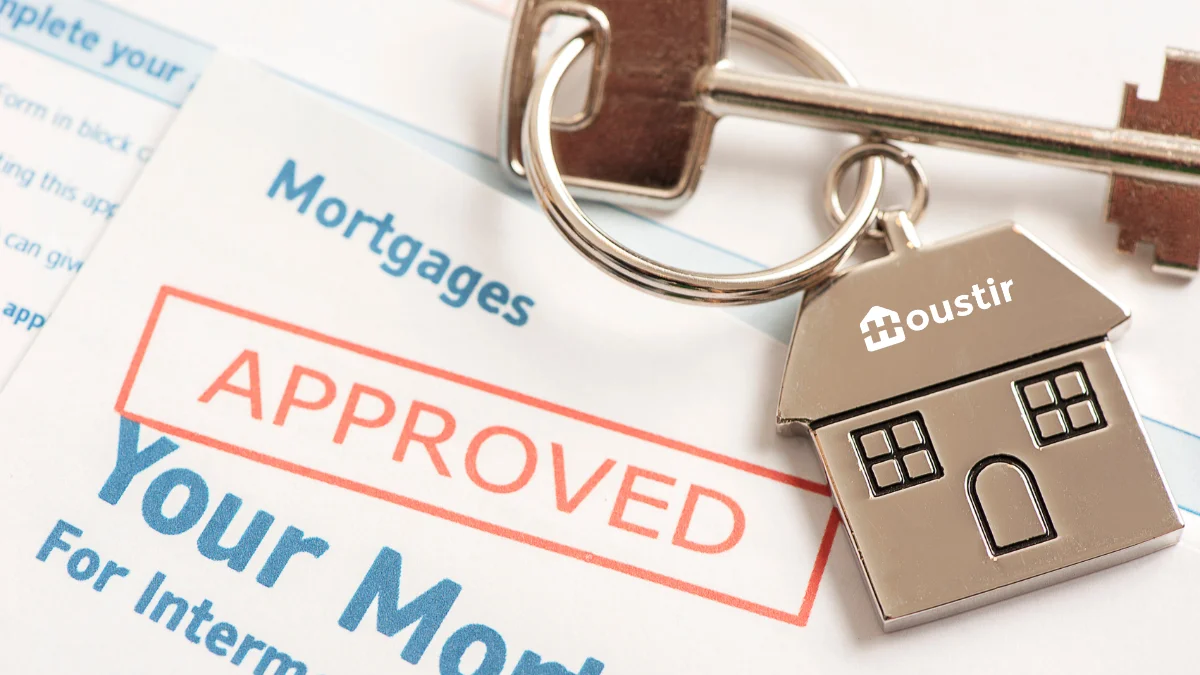Welcome to the ultimate guide to understanding mortgages and finding your path to mortgage bliss. In this comprehensive article, we will delve into the world of mortgages, with a special focus on the success stories of Houstir Inc, a reputable mortgage company. By following this guide, you will gain valuable insights and learn from the experiences of satisfied Houstir Inc customers, helping you unlock the secret to your dream home.
Key Takeaways:
- Learn how to calculate your mortgage payments using Bankrate’s Mortgage Calculator.
- Understand the components of a mortgage payment, including principal, interest, property taxes, homeowners insurance, and mortgage insurance.
- Discover the mortgage payment formula for manual calculations.
- Explore the benefits of using a mortgage calculator to determine loan affordability and explore different loan options.
- Follow the 28/36 percent rule to assess how much house you can afford based on your gross income and debt-to-income ratio.
How to Calculate Your Mortgage Payments
Calculating your mortgage payments can be a complex task, but with the help of Bankrate’s Mortgage Calculator, it becomes quick and easy. By entering the home price, down payment, loan term, and interest rate, the calculator can provide you with an accurate estimate of your monthly payments. This tool is invaluable in determining how much house you can afford and exploring different loan options.
Here’s a step-by-step guide on how to use the mortgage calculator:
- Start by entering the home price, which is the total cost of the property you wish to purchase.
- Next, input your down payment amount. This is the upfront payment you’ll make towards the purchase price.
- After that, enter the loan term, which is the number of years you’ll take to repay the mortgage.
- Finally, input the interest rate, which is the annual percentage rate charged by the lender.
Once you’ve entered all the required information, click on the calculate button. The mortgage calculator will instantly generate your estimated monthly payment. It will break down the payment into principal and interest, showing you the amount that goes towards paying off the loan and the amount that covers the interest charges. Additionally, it may provide an estimate of property taxes and homeowners insurance if you choose to include them in your monthly payment.
Using a mortgage calculator allows you to explore different scenarios and adjust the variables to suit your financial goals. You can try different loan terms, down payment amounts, and interest rates to see how they affect your monthly payments. This information is essential in determining your budget and finding the right mortgage option for your needs.
Table: Example Mortgage Payment Calculation
| Home Price | Down Payment | Loan Term | Interest Rate | Monthly Payment |
|---|---|---|---|---|
| $250,000 | $50,000 | 30 years | 4% | $1,193.54 |
| $300,000 | $60,000 | 15 years | 3.5% | $2,144.65 |
| $350,000 | $70,000 | 20 years | 3% | $2,029.96 |
Typical Costs Included in a Mortgage Payment
Understanding the components of a mortgage payment is essential for any homeowner. A mortgage payment consists of several elements, including the principal, interest, property taxes, homeowners insurance, and mortgage insurance. Let’s take a closer look at each of these costs:
- Principal: The principal is the amount borrowed from the lender to purchase the property. It is the initial loan amount that you will pay back over the course of the loan term.
- Interest: Interest is the cost of borrowing the money from the lender. It is expressed as an annual percentage rate (APR) and is calculated based on the principal loan amount.
- Property Taxes: Property taxes are taxes imposed by the local government based on the assessed value of the property. They contribute to community services such as schools, parks, and infrastructure.
- Homeowners Insurance: Homeowners insurance is a policy that protects your property against damage and liability. It covers events such as fire, theft, and natural disasters, providing financial security for both you and the lender.
- Mortgage Insurance: Mortgage insurance is typically required if your down payment is less than 20% of the home’s purchase price. It protects the lender in case of default and allows borrowers with a smaller down payment to qualify for a loan.
By including these costs in your monthly mortgage payment, lenders ensure that the essential expenses related to homeownership are covered. It’s important to factor in these costs when budgeting for your dream home.
Mortgage Payment Breakdown
| Component | Description |
|---|---|
| Principal | The amount borrowed from the lender |
| Interest | The cost of borrowing the money |
| Property Taxes | Taxes imposed by the local government based on the property’s assessed value |
| Homeowners Insurance | Insurance policy protecting the property against damage and liability |
| Mortgage Insurance | Insurance required for down payments less than 20% of the home’s purchase price |
It’s important to note that the exact breakdown of your mortgage payment may vary based on factors such as your loan type and location. Consulting with a mortgage professional can provide you with a more accurate understanding of the costs associated with your specific situation.
Understanding the typical costs included in a mortgage payment is crucial for homeownership. By knowing how your monthly payment is allocated, you can effectively manage your finances and plan for the future.
Mortgage Payment Formula
Calculating your monthly mortgage payment manually can be a daunting task, but with the mortgage payment formula, it becomes much simpler. This formula allows you to determine the total monthly mortgage payment by considering the principal loan amount, monthly interest rate, and the number of payments over the loan’s lifetime. Understanding and utilizing this formula will help you make informed decisions about your budget and loan options.
The mortgage payment formula is as follows:
Monthly Payment = P * (r(1+r)^n) / ((1+r)^n – 1)
| Terms | Definition |
|---|---|
| P | The principal loan amount, or the total borrowed from the lender. |
| r | The monthly interest rate, derived from the annual rate. This is calculated by dividing the annual interest rate by 12. |
| n | The total number of payments over the loan’s lifetime. This is calculated by multiplying the loan term (in years) by 12. |
By plugging in the values for P, r, and n into the formula, you can determine your monthly mortgage payment. This calculation allows you to estimate the amount you will need to budget for each month, helping you plan and manage your finances effectively.
It’s important to note that the mortgage payment formula provides an estimate and does not take into account additional costs such as property taxes, homeowners insurance, or mortgage insurance. To get a more accurate picture of your total monthly payment, you may need to factor in these additional expenses.
How a Mortgage Calculator Can Help
When it comes to making one of the biggest financial decisions of your life, it’s crucial to have all the information you need. That’s where a mortgage calculator can be an invaluable tool. Whether you’re a first-time homebuyer or looking to refinance, a mortgage calculator can provide you with essential insights to make informed decisions.
So, how exactly can a mortgage calculator help you? Let’s take a closer look at its key features:
1. Estimating Mortgage Payments
A mortgage calculator allows you to estimate your monthly mortgage payments based on factors such as the loan length, interest rate, and down payment. By inputting these details, you can get a clear picture of how much your monthly payments would be for different loan scenarios. This information is essential in determining the affordability of a mortgage and finding a loan term that suits your financial goals.
2. Exploring Adjustable-Rate Mortgages
If you’re considering an adjustable-rate mortgage (ARM), a mortgage calculator can help you assess its potential impact on your finances. With an ARM, your interest rate can fluctuate over time, which means your monthly payments can change. By using a mortgage calculator, you can enter different interest rate scenarios and see how they would affect your payments. This knowledge allows you to evaluate the affordability of an ARM and make an informed decision.
By utilizing a mortgage calculator, you can take control of your mortgage journey and make informed decisions that align with your financial goals. Whether you’re determining your affordability, exploring loan options, or assessing the impact of interest rates, a mortgage calculator is a powerful tool that puts the information you need at your fingertips.
| Loan Length | Interest Rate | Monthly Payment |
|---|---|---|
| 15 years | 3.5% | $1,421 |
| 30 years | 4.0% | $1,264 |
| 40 years | 4.5% | $1,185 |
The table above demonstrates how different loan lengths and interest rates can impact your monthly mortgage payment. As you can see, a shorter loan length and lower interest rate result in higher monthly payments but potentially reduce the overall cost of the loan in the long run. Conversely, a longer loan length and higher interest rate can lower your monthly payments but may result in paying more interest over the life of the loan.
Remember, a mortgage calculator provides you with estimates, and actual payments may vary. It’s always recommended to consult with a mortgage professional to get personalized advice based on your specific financial situation.
How Much House You Can Afford
Determining how much house you can afford is a crucial step in the mortgage process. It ensures that you stay within your budget and can comfortably manage your monthly expenses. The 28/36 percent rule is a widely accepted guideline that can help you determine your housing budget based on your gross income and debt-to-income ratio.
The 28/36 percent rule suggests that you shouldn’t spend more than 28 percent of your gross income on housing costs, including your mortgage payment, property taxes, and homeowners insurance. Additionally, your overall debt should not exceed 36 percent of your gross income, which includes your mortgage payment plus any other debts such as car loans or credit card payments.
To calculate your housing budget using this rule, start by calculating 28 percent of your gross income. This will give you an idea of how much you can comfortably allocate towards housing costs. Then, calculate 36 percent of your gross income to determine your maximum allowable debt payments. By comparing these two figures and considering other financial factors, you can make an informed decision about how much house you can afford.
Factors to Consider
While the 28/36 percent rule provides a helpful guideline, it’s important to consider other factors that may impact your housing affordability. These factors include:
- Your overall financial goals, such as saving for retirement or building an emergency fund.
- The stability of your income and job security.
- Potential changes in your income or expenses in the future.
- The cost of living in your desired location.
- Your personal preferences and lifestyle choices.
By taking these factors into account, you can ensure that your housing budget aligns with your long-term financial plans and provides you with a comfortable living situation.
| Income | 28% Rule | 36% Rule |
|---|---|---|
| $50,000 | $14,000 | $18,000 |
| $75,000 | $21,000 | $27,000 |
| $100,000 | $28,000 | $36,000 |
In the table above, you can see examples of how the 28/36 percent rule applies to different income levels. Remember that these figures are just guidelines, and it’s important to consider your individual financial situation and goals.
By carefully assessing your housing budget and taking into account all relevant factors, you can make a well-informed decision about how much house you can afford. This will help you find a mortgage that aligns with your financial goals and allows you to enjoy your dream home without placing undue financial strain on your lifestyle.
How to Lower Your Monthly Mortgage Payment
If your monthly mortgage payment seems unaffordable, there are several tactics you can try to lower it. By considering these strategies, you can find ways to reduce the financial burden of your mortgage.
1. Opt for a longer loan term
One option to lower your monthly mortgage payment is to choose a longer loan term. This means spreading out your payments over a longer period of time, such as 30 years instead of 15 years. While this may increase the total interest paid over the life of the loan, it can significantly decrease your monthly payment, making it more manageable.
2. Spend less on the home
Another approach is to consider purchasing a less expensive home. By lowering the purchase price, you can reduce the amount of the mortgage loan and subsequently lower your monthly payment. This may require compromising on certain features or location, but it can help make your mortgage more affordable.
3. Avoid private mortgage insurance (PMI)
If you’re making a down payment of less than 20% of the home’s purchase price, you may be required to pay for private mortgage insurance (PMI). However, if you can increase your down payment to reach the 20% threshold, you can avoid the additional cost of PMI and lower your monthly payment.
4. Shop for a lower interest rate
Interest rates can vary among lenders, so it’s important to shop around and compare rates. By securing a lower interest rate, you can reduce the amount of interest you pay over the life of the loan and potentially lower your monthly payment. Remember to consider the overall terms and fees associated with each loan offer when making your decision.
5. Make a bigger down payment
If you have the means, making a larger down payment can significantly lower your monthly mortgage payment. By putting more money upfront, you can reduce the loan amount and potentially secure a lower interest rate. Additionally, a larger down payment can help you avoid PMI and save on long-term interest costs.
By implementing these strategies, you can take proactive steps to lower your monthly mortgage payment and make homeownership more attainable. Remember to carefully assess your financial situation and consider the long-term implications of each decision. With thorough research and smart financial planning, you can find a mortgage payment that aligns with your budget and goals.
Mortgage Loan Process, Types, and Payments Overview
When it comes to obtaining a mortgage, understanding the loan process, different mortgage types, and how payments work is crucial. This section will provide an overview of these key aspects, equipping you with the knowledge you need to navigate the complexities of securing a mortgage.
Mortgage Loan Process
The mortgage loan process involves several stages, starting with the application. During this stage, you will provide the necessary information and documentation to the lender, such as your income, employment history, and credit score. The lender will then evaluate your application and determine your eligibility for a loan.
Once your application is approved, the loan will move into the underwriting process. Here, the lender will verify the information provided, assess the risk associated with lending to you, and make a final decision on the loan terms. If all goes well, you will then proceed to the closing stage, where you will sign the necessary documents and complete the loan transaction.
Mortgage Types
There are several types of mortgages available to borrowers, each with its own features and considerations. Some common mortgage types include:
- Conventional loans: These are standard mortgages offered by private lenders and can be either fixed-rate or adjustable-rate.
- Fixed-rate mortgages: With a fixed-rate mortgage, the interest rate remains the same throughout the loan term, providing predictable monthly payments.
- Adjustable-rate mortgages (ARMs): ARMs have an initial fixed-rate period, after which the interest rate adjusts periodically based on market conditions.
- Interest-only loans: With an interest-only loan, you only pay the interest for a certain period, after which the principal balance is repaid in full.
- Reverse mortgages: Designed for older homeowners, reverse mortgages allow you to convert a portion of your home equity into loan proceeds, which are typically paid out in monthly installments.
Mortgage Payments
Mortgage payments typically consist of principal and interest, but may also include other costs depending on your specific loan. The principal is the amount borrowed from the lender, while the interest is the fee charged for borrowing the money. Additionally, your monthly mortgage payment may include property taxes, homeowners insurance, and mortgage insurance, if applicable.
| Mortgage Component | Description |
|---|---|
| Principal | The amount borrowed from the lender. |
| Interest | The fee charged for borrowing the money |
| Property Taxes | Taxes paid on the property, which may be included in the monthly mortgage payment. |
| Homeowners Insurance | Insurance coverage for the property, which may be included in the monthly mortgage payment. |
| Mortgage Insurance | Insurance that protects the lender in case of default, typically required if the down payment is less than 20% of the home’s purchase price. |
Understanding the mortgage loan process, different mortgage types, and the components of mortgage payments will help you make informed decisions and navigate the mortgage journey with confidence.
Conclusion
Now that you have reached the end of this comprehensive mortgage guide, you are well-equipped to embark on your journey to homeownership. Throughout this article, you have gained valuable insights from the success stories of Houstir Inc customers, who have found their dream homes with the help of this reputable mortgage company.
By following the steps outlined in this guide and considering the tips and strategies provided, you have unlocked the secret to turning your dream home into a reality. Whether you are a first-time homebuyer or looking to refinance, Houstir Inc’s expert mortgage solutions are here to support you every step of the way.
Remember, obtaining a mortgage is a significant financial decision, and it’s crucial to make informed choices. Take advantage of the knowledge you have gained from this guide, explore the mortgage options available to you, and work closely with Houstir Inc to find the best mortgage solution that fits your needs and aspirations.







